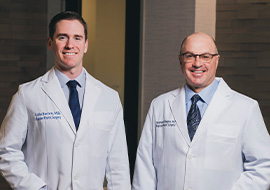
Ectropion Surgery
Correction of outwardly turned eyelid
Ectropion is an outward turning of the eyelid margin. Ectropion can cause dryness of the eyes, excessive tearing, red eyes, and increased sensitivity to light and wind. It may occur unilaterally or bilaterally and is almost always in the lower eyelid. Acquired causes of ectropion include: involutional (due to aging or involutional changes), paralytic (due to seventh cranial nerve palsy), cicatricial (due to scarring), inflammatory, or mechanical.
Correction of involutional and paralytic ectropion is generally performed with local anesthesia as an outpatient. It may also be performed as an office procedure. The surgery typically involves tightening the lower eyelid and rotating the eyelid margin back into a more normal position. A small incision is made in the outside corner (lateral canthus) of the eyelid. The eyelid is tightened by reattaching the tarsus (the thick, middle layer of the eyelid) to the bone of the lateral orbital rim. This surgery is referred to as a Lateral Tarsal Strip Procedure.
If a cicatricial (scarring) process is present, the skin disease should be treated first. If the eyelid is still turned out once the skin is quiet, a full-thickness skin graft or local skin-muscle (myocutaneous) flap may be required. Skin may be taken from in front of or behind the ear or just above the clavicle if a skin graft is required.
 Watch to learn more about Entropion / Ectropion Surgery
Watch to learn more about Entropion / Ectropion Surgery
After the Procedure
A topical antibiotic is typically applied to the operated areas during the first postoperative week. Ice packs are recommended as with other eyelid surgeries for 2-3 days. It is important that the tightened eyelid not be disrupted during the first 3 weeks of healing. A protective eye shield (plastic or metal) may be useful while sleeping to minimize the risk of inadvertant wound disruption.
View Before/After Photos

Klapper Eyelid & Facial Plastic Surgery treats disorders, injuries, and other abnormalities of the eyelids, eyebrow, tear duct system, eye socket, and adjacent areas of the mid and upper face.
